| |
Extra
Solar Planets - Known Worlds Round Other Stars
| |
Until
very recently, the possibility of planets around other stars
was merely scientific conjecture and the mainstay of science
fiction.
Although in our galaxy of about 300,000,000,000 stars it was
a almost a certaintly that our solar system was not unique in
forming planets, there was no direct evidence until the mid-nineties
when methods were developed to look for celestial bodies smaller
than stars.
Methods of Detecting Stars Around Other Planets
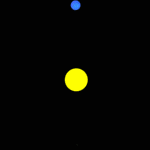
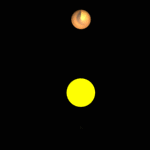 |
The
animations on the left demonstrate the difference in the
wobble of a parent star depending on whether the orbiting
planet is small or large and also how close it is.
If observed from above as with the animations, the circular
orbit of the star around the common centre of gravity is
seen and this is called Astrometry. This method is unreliable,
but the same wobble can be detective using via other means.
If you imagine an abulance driving in rapid circles a short
distance away you would hear the pitch of the siren rise
and fall depending on its movement towards or away. The
same principle applies to light as well as sound, and this
Doppler Shift of the light allows the direction to be determined
in the same way. Wobbles in the light of the star means
that it is being flung around by another massive object,
and if no other light source is visible it can only be a
massive planet. More complex and disturbed wobbles allow
even more planets to be detected around the same star.
For solar systems which appear edge-on to observers on Earth, |
the
transit of the planet across the face of the star can be used
to detect their existance by observing how much dimmer the star
becomes. This method, although somewhat unreliable, allows for
more data to be gathered about the planet, such as temperature,
atmosphere and size.
There is only one method for detecting planets similar to the
mass of Earth: Gravitational Microlensing. This is an intricate
system whereby a star in the foreground can warp the light of
a star in the background. If the foreground star also has a planet
then the lensing effect is even greater.
Seeing Planets Around Other Stars
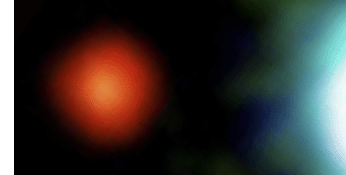 This
image on the right may not look like much but it is very significant
in astronomical history. This is the only confirmed image ever
made of a planet around another star. The star is a brown dwarf
designated 2M1207 and the planet is called 2M1207b and
the picture is an infrared image. A handful of other possible
sub-stellar objects have been observed in infra-red but may be
brown dwarf stars. This
image on the right may not look like much but it is very significant
in astronomical history. This is the only confirmed image ever
made of a planet around another star. The star is a brown dwarf
designated 2M1207 and the planet is called 2M1207b and
the picture is an infrared image. A handful of other possible
sub-stellar objects have been observed in infra-red but may be
brown dwarf stars.
The planet 2M1207b is a gas giant, still hot enough to give off
detectable infra red, with approximately 20 times the mass of
Jupiter. Despite the enormous mass, Jupiter would be about two
thirds the diameter of this exo-planet. 2M1207b orbits its parent
star a little further out than Pluto orbits our sun. Below is
an artist's impression of this huge planet which exists 173 light
years from our own solar system. |
|
| |
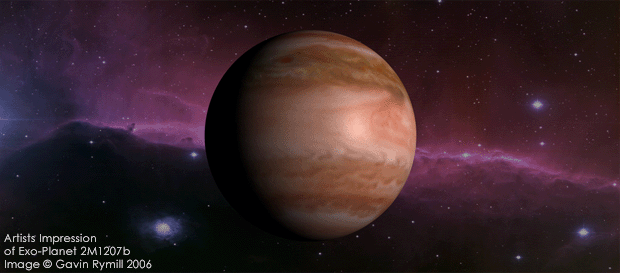
Single
Known Gas Giants
The
illustration below shows three different solar systems (four
including our own in grey) all overlaid on top of each other,
if their parent stars were all in the same place.
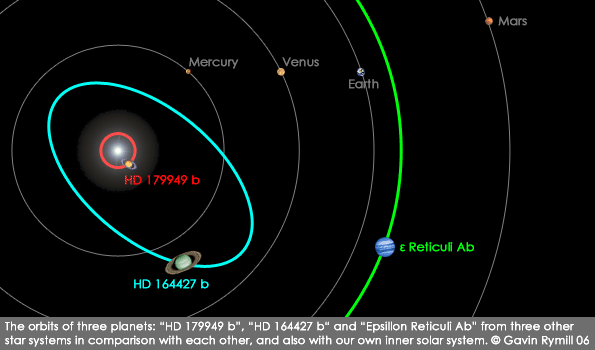
In
red at the centre is the
remarkable planet DH 179949 b
which orbits so close to its parent star that it only takes
three days to complete one orbit. It has the same mass as Jupiter
and therefore also likely to be a gas giant. Planets like this
are most easily detected from Earth because of their severe
influence over the parent star and the regularity with which
they orbit. In light blue is
planet HD 164427 b
which has an eccentric orbit taking it from the equivalent of
inside Mercury's orbit, to out near Venus's. In green
is Epsilon Reticuli Ab which
is a gas giant about 30% more massive than Jupiter.
The Star Syetem of Mu Arae

This star system has a yellow star at its centre, slightly bigger
than our sun. Very close in orbit is planet Mu Arae d
which is about 14 times the mass of the Earth and therefore
one of the lightest planets discovered and probably a massive
rocky planet. It orbits so close to the star that it only takes
9.5 days to complete a "year" rotation and its surface
temperature is estimated to be 600 degrees celcius. Between
the equivalent orbits of Venus and Earth lies Mu Arae e
and further out is gas giant Mu Arae e, slightly bigger
than Jupiter. This planet lies in the habitable zone around
the star where liquid water and therefore life may exist. Although
life cannot exist on the gas planet itself, it is quite possible
that any large moons could be hospitable. Further out is another
gas planet Mu Arae c. Along with these known planets
it is of course possible that smaller, rocky worlds exist which
are too small for our methods to detect.

As well as quite typical planetary sysems, others have been
found which almost defy explanation. Above is the system of
HD 188753 which includes not only the gas giant HD 188753
Ab orbiting extremely close to the star but further out
are two more stars which orbit each other. It is the only known
triple star system which also contains a planet and goes against
current theories which suggest gas giants form further out and
migrate inwards.
Only a couple of small rocky worlds have been found. As well
as the likely Mu Arae d, which is still large by Earth
standards, the world OGLE-2005-BLG-390Lb may only be
about 5.5 times the mass of the Earth. Unfortunately however
as it orbits a red dwarf star at two and a half times the distance
Earth orbits the sun, there is no chance of life.
The search goes on for Extra-solar planets and all the time
more unusual systems are being found, as well as more Earth-like
ones. As time goes on, methods will be refined and our picture
of the galaxy will become one of a place filled with multi-planet
solar systems like ours.
Click here to learn about
recent changes to the view of our solar system.
Images and Text © Gavin Rymill 2006 |
|